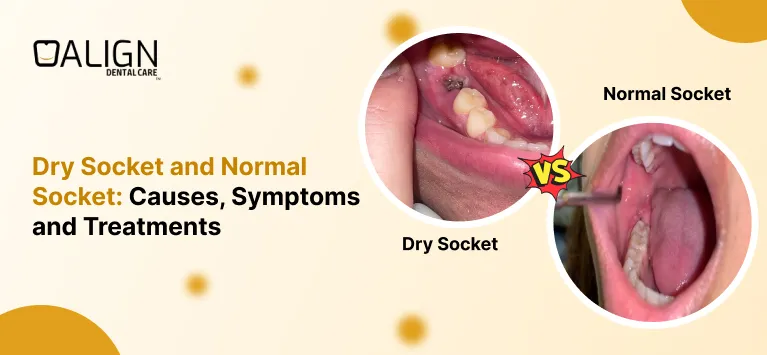
Dry Socket vs Normal Socket : Causes, Symptoms and Treatments
Tooth extractions are common dental procedures, but the healing process can vary significantly depending on whether a normal or dry socket develops. A normal socket forms as a healing cavity where the tooth is removed, characterized by a blood clot that protects the underlying bone and nerves, aiding in healing. In contrast, a dry socket is a painful complication that occurs when the blood clot is lost or fails to form, exposing the bone and causing intense discomfort. This blog will explore the key differences between normal sockets and dry sockets, including their healing processes, symptoms, causes, treatments, and prevention strategies.
Table of Contents
Normal Socket After Tooth Extraction
A normal socket after tooth extraction is the healing cavity left in the gum where the tooth was removed. It is characterized by the formation of a blood clot that protects the underlying bone and nerves. This clot is essential for healing, as it prevents infection and allows new tissue to regenerate. In a normal socket, patients typically experience mild pain and swelling, which gradually decrease as the socket heals over the following weeks to months.
Healing Normal Socket After Tooth Extraction
After a tooth is extracted, the socket heals step by step. First, a blood clot forms in the empty socket, which helps protect the bone and nerves underneath. Over the next few days, the gum tissue starts to close up, and the pain begins to decrease. Within a week or two, the socket continues to heal as new tissue grows. After about a month, the bone starts filling in the space, and the soft tissue usually finishes healing. Complete bone healing may take a few months, but with proper care, the recovery should be smooth and uncomplicated.
Causes of Normal Socket
A normal socket forms after a tooth extraction is done. This healing cavity is essential for recovery and is influenced by several causes:
- Successful Tooth Removal: A careful and smooth extraction minimizes damage to surrounding tissues, promoting better healing.
- Blood Clot Formation: The socket experiences a blood clot right after the extraction. This clot is important because it shields the nerves and bone underneath.
- Good Blood Flow: Healthy blood circulation delivers important nutrients and oxygen to the area, which aids in the healing process.
- Body’s Healing Response: The body’s natural healing mechanisms work to repair the area, preventing infection and encouraging new tissue growth.
Symptoms Of Normal Socket
Symptoms of a normal socket after tooth extraction typically indicate that the healing process is proceeding well. These symptoms include:
- Mild Pain: Some discomfort is normal, but it should be manageable and gradually decrease over a few days.
- Swelling: Mild swelling around the extraction site is common but should start to diminish within a few days.
- Soreness: The area may feel tender, especially when touched, but this should improve as healing progresses.
- Normal Bleeding: Some bleeding may occur immediately after the extraction, but it should stop within a few hours. Any residual blood should be minimal.
- Closure of the Socket: Over time, the socket should gradually close up as new tissue forms over the area
How To Treat Normal Socket?
Here are treatment tips for a normal socket after tooth extraction:
- Saltwater Rinse: Gently rinsing with warm salt water helps keep the area clean and aids healing.
- Avoiding Straws: Using straws can dislodge the blood clots and prevent them for the first few days.
- Cold Compress: Applying a cold compress can help reduce swelling and pain.
- Soft Foods: Eating soft foods prevents irritation of the socket and promotes healing.
- Good Oral Hygiene: Maintain good oral hygiene, but avoid brushing directly on the extraction site for a few days to prevent irritation.
- Stay Hydrated: Drink plenty of fluids to stay hydrated, but avoid hot drinks for the first few days.
What is Dry Socket?
A dry socket, also called alveolar osteitis, is a painful dental condition that can occur after a tooth extraction, especially from the wisdom teeth. Normally, a blood clot forms in the tooth socket to protect the bone and nerves as the area heals. In the case of a dry socket, the clot either dissolves or becomes dislodged, leaving the underlying bone and nerves exposed. This leads to intense pain, delayed healing, and often a bad taste or odour in the mouth.
Symptoms Of Dry Socket After Tooth Extraction
Symptoms of dry socket (alveolar osteitis) after tooth extraction can include:
- Severe Pain: Intense pain that typically starts 2-4 days after the extraction and can radiate to the ear, eye, or side of the face.
- Empty Socket:An absence of a blood clot in the socket, which may appear dry or empty.
- Bad Breath: A foul odour coming from the extraction site.
- Unpleasant Taste: A bad taste in the mouth due to the exposure of the bone.
- Swelling: Possible swelling around the extraction site.
- Delayed Healing: Slower than expected healing of the socket.
Causes of Dry Socket
Dry socket (alveolar osteitis) can occur due to several factors, including:
- Dislodged Blood Clot: If the blood clot that forms in the socket is dislodged or dissolves prematurely, it can lead to a dry socket.
- Inadequate Blood Supply: Conditions that affect blood flow to the extraction site can increase the risk of dry sockets.
- Smoking: Tobacco use can interfere with blood clot formation and healing, increasing the likelihood of dry sockets.
- Infection: Bacterial infections at the extraction site can disrupt the healing process and lead to complications.
- Hormonal Changes: Hormonal fluctuations, particularly in women (e.g., during menstruation or hormone therapy), may affect healing and increase the risk.
- Trauma to the Socket: Activities that disturb the extraction site, such as vigorous rinsing or spitting, can dislodge the blood clot.
- Poor Oral Hygiene: Insufficient oral care can lead to infections and complications during the healing process.
- Complex Extractions: More complicated extractions, such as those involving impacted wisdom teeth, can have a higher risk of dry sockets due to increased trauma to the surrounding tissues.
How Does Dry Socket Look Like?
A dry socket, a common complication after tooth extraction, occurs when the blood clot protecting the extraction site is dislodged or dissolves prematurely. This leaves the bone and nerves exposed, leading to intense pain and delayed healing. Visualizing a dry socket after tooth extraction pictures can help identify its appearance and differentiate it from normal post-extraction healing.



How To Treat Dry Socket?
- Flushing Out the Socket: A dentist may gently flush the socket to remove debris and bacteria.
- Dental Intervention: Cleaning the socket and possibly placing medicated dressings to promote healing and alleviate pain.
- Pain Management: Prescription pain relievers may be necessary to control severe discomfort.
- Antibiotics: May be prescribed to manage or prevent infection, especially if there are signs of complications.
- Self-Care: Patients can maintain oral hygiene by rinsing with warm salt water (as directed) to reduce the risk of infection.
Preventing Dry Socket After A Tooth Extraction
Here are some tips for preventing dry socket after a tooth extraction, including the importance of proper oral hygiene:
- Avoid Smoking and Tobacco: Refrain from smoking and using tobacco products for at least 48-72 hours after the extraction, as they can hinder healing and dislodge blood clots.
- Avoid Straws: Don’t use straws for at least a week after the extraction, as the suction can dislodge the blood clot.
- Maintain Proper Oral Hygiene: Gently brush your teeth while avoiding the extraction site to keep your mouth clean and reduce the risk of infection.
- Eat Soft Foods: Stick to soft foods for the first few days post-extraction, avoiding hard, crunchy, or hot foods that can irritate the socket.
- Use Pain Medication as Directed: Take any prescribed pain medication to manage discomfort, which can help you avoid inadvertently disturbing the extraction site.
Dry Socket vs Normal Socket
The main difference between dry socket pain vs normal pain after tooth extraction is that a normal socket features a stable blood clot that protects the underlying bone and facilitates healing, while a dry socket occurs when the blood clot is dislodged or fails to form, exposing the bone and resulting in severe pain and delayed healing. Here are some key differences listed:
| Feature | Normal Socket | Dry Socket |
| Definition | Socket healing with a blood clot | Complication where the blood clot is dislodged or absent |
| Pain | Mild to moderate pain that decreases over time | Severe, sharp pain that begins a few days post-extraction |
| Healing Process | Clot present, socket may appear reddish | Empty, dry socket with exposed bone visible |
| Swelling | Mild swelling around the extraction site | Increased swelling in the area |
| Odor | No significant odor | Foul odor due to bone exposure |
| Taste | Normal taste, no unpleasant sensations | Bad taste in the mouth due to exposed tissue |
Pictures of Dry Socket vs Normal Healing

Conclusion
Understanding the difference between a normal socket and a dry socket is important after tooth extraction. A normal socket heals with little discomfort, while a dry socket can cause severe pain and complications. Knowing the signs of each, following care instructions, and taking precautions can help ensure a smooth recovery. If you have severe pain or signs of a dry socket, see your dentist right away for treatment. With proper care, you can heal well and reduce the chance of complications.












